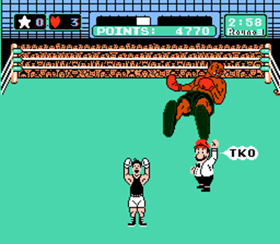 All too often the relationship between IT folk and business people looks more like the 80’s video game “Punch Out” and less like a team working together for the win. It doesn’t matter which side is trying to run the show, more often than not the relationship is confrontational and antagonistic. It all comes down to this basic problem: business doesn’t understand IT and IT doesn’t understand business. Neither side has the luxury of enough time to learn a new language. Neither side has the time to truly communicate. Very few business people understand technology well enough to take advantage of the possibilities. Very few IT folks understand the needs of the business well enough to know how or what IT capabilities to bring to bear.
All too often the relationship between IT folk and business people looks more like the 80’s video game “Punch Out” and less like a team working together for the win. It doesn’t matter which side is trying to run the show, more often than not the relationship is confrontational and antagonistic. It all comes down to this basic problem: business doesn’t understand IT and IT doesn’t understand business. Neither side has the luxury of enough time to learn a new language. Neither side has the time to truly communicate. Very few business people understand technology well enough to take advantage of the possibilities. Very few IT folks understand the needs of the business well enough to know how or what IT capabilities to bring to bear.
From the IT perspective, creating change is like Punch Out’s Little Mac taking on Tyson – theoretically possible, but in reality more of a beat down. At least until you can unlock the right combination of moves, or in our case, find the right combination of communication and timing to really be effective.
I’ve spent 20+ years in IT and so it’s easy for me to speak from the IT perspective. I speak fluent geek. But I have also spent the last 10 years or so learning to speak business as a second language. What I have found in looking at and working with so many companies is that the most valuable employees are the ones that can bridge the gap. And as much as I hated this fact earlier in my career, IT is still less about technology and more about personality and politics. I spent the first few years of my career concentrating on technologies and ignoring people. This was not the smartest move on my part. In my idealistic state of youth, I thought reality would bend to what I thought it should be. Sigh, no such luck.
 So what does it take to put Tyson on the mat? To really find the funding to get the right tool at the right time? Well, if you’re a geek like me you’re probably not going to like it. Communication makes the world go round and communication is the only way to make a real impact. Very few, if any, changes occur when one person heroically toils alone. Even Hercules needed someone to fight and someone to tell the story. If you want to get anything done you have to get good at communicating.
So what does it take to put Tyson on the mat? To really find the funding to get the right tool at the right time? Well, if you’re a geek like me you’re probably not going to like it. Communication makes the world go round and communication is the only way to make a real impact. Very few, if any, changes occur when one person heroically toils alone. Even Hercules needed someone to fight and someone to tell the story. If you want to get anything done you have to get good at communicating.
True communication is more than knowing everything there is to know about your side. It’s not enough to be good at the bits and bytes of technology. You have to understand both sides of the problem and approach people in a way they understand. Telling a CEO or CIO about the coolest new tech doesn’t carry a lot of weight. Unless, of course, your CEO is a fellow geek, in which case there is probably a board of directors or a CFO lurking in the background, ready to put the brakes on. I mean someone has to ask the tough questions, like what do I get for my truckload of cash? Or, why do we need the biggest, fastest, most complex Hadoop cluster in creation? And, most importantly, how does this solve MY problem?
Remember back when IP telephony came out? Pretty cool, right? But how many business people “got it” at first? IT had to get good at explaining how IP telephony was not just cool, but it saved you money, gave you more flexibility, and made life a little easier. That’s when it really took off. Now, IP telephony is a given. Old ways do change, but it takes the right reasons. (It’s no accident I listed “saves money” first.)
My suggestion, IT folks, is to spend some time figuring out where your company is going. Start at the beginning and ask questions. What makes it tick? What’s causing the pain? What’s keeping your boss up at night? What about his boss? Answer those questions and find a way to use technology to their advantage. The real future in IT is fitting business problems together with technology solutions, not just keeping the network up.
